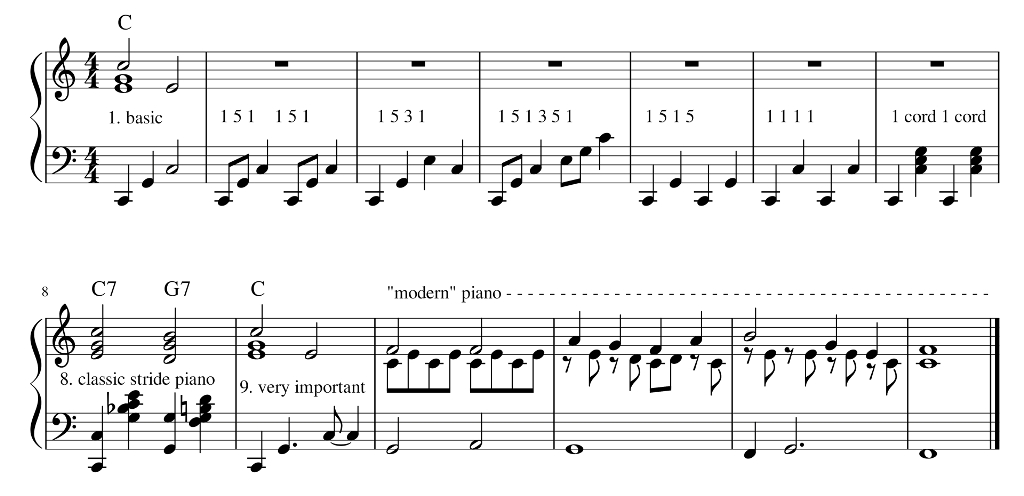
learn to play the piano like a pro (03)
You only live twice
The composer John Barry was a true master of melody making. First we will repeat some fundamentals :

1. measure We have the basic : under melody note c we have put 5 and 3 (we need not 5 but it is more convenient in playing to have). In left hand we have
1 5 1 - the last 1 we play together with melody note e because e is part of the C cord.
3. measure 1 5 3 1 could also be played 1 5 3 5.
8. measure This is classic stride piano. You play the melody one octave up from the notation. Left hand : the root bas note is often played in octave. After
the root bas note you have a full cord (often in inversions in order not to collide with a melody note and not to stretch your hand to much). All is played
in perfect quarter notes. This creates a very "correct" playing, but I tell you it is difficult. Moulin rouge is played in this classic way - it is in 3/4 time
and it is because of that a little more easy (left hand only one bas root note followed by two full cords). The well-known song Edelweiss could be played
the same way.
counting : I don't do much counting but of course you must understand the principle. In 4/4 time we count : 1 and 2 and 3 and 4 and ( 8 times 1/8 note).
On 1, 2, 3, 4 we have the beat. On 1 and 3 we often have a cord shift. This is to tell you that some pro piano players play in all 1/8 - they have a melody
note or/and cord note on every 1/8 in the measure. This creates a very flowing playing.
9. measure is extremely important to fully understand. It is like 1. measure but the last note in the left hand is moved away from the above melody note.
The melody note is a part of the cord notes but nevertheless we don't want to play it together with the left hand note. As a rule we only play left and
right hand notes together on cord shift. We have an important exception and that is when we can hear it is right to do so (it comes naturally with
training). You can never change the melody line apart from very carefully adding some fill ins. You can do whatever you like in the left hand - not that
you should. You may ask why is this important? It is because a melody note (not part of the cord notes) together with a cord note can create dissonance.
Likewise we never put cord notes below melody notes unless the melody note is part of the cord notes. We have a problem and that is when we have a
melody note (not part of the cord notes) on a cord shift - what do we do? Most piano players ignore this but it is a good idea to somewhat isolate the
melody note with some distance to the other notes or not putting cord notes below this melody note altogether. (It is often seen with suspended cords that
immediately are resolved - the suspended cord is hidden).
10. measure Modern sheet music is often written by people not playing the piano. It has a melody line (sung by a singer). With the melody line is some
cords and fill ins (played by a guitar). For the left hand a single bas line (played by a bas guitar). This is very lousy. Firstly you have no problem in
hearing the difference between a singer and a guitar - but on a piano there is no difference. Playing the cords and fill ins should be very soft compared
to playing the melody line - and I know very few piano players that can do this. The result is that the melody is destroyed because of the nearness of the fill ins .
Secondly what is the left hand doing? Very little and playing a bas line means that you must shift the sustain pedal on every bas note in order not to create rumble.
In short : modern sheet music is useless for playing the piano. You must create your own sheet music.
I play from fake books. The quality of these is very varied to say the least. I can recommend "101 Hits for Buskers". Also I can recommend you to get
MuseScore - free and open source - a brilliant program to write music in and very easy to use.
Lastly I recommend you to make it simple - one can immediately hear if a piano player does not have control over the playing. Play in as few keys as
possible. My favorite (as most composers and singers) is E flat major. You can always transpose the key in MuseScore. If you play in few keys there will be
less cords to learn. It is an absolute must that you know your cords - you must be able to see them on the keyboard.
Now you have the theory to play You only live twice. In the video you can see exactly what I do. It takes times. You must work with it, but the reward will
be big in the end. This song is only hard work, because there is nothing special in this song. It is straightforward. Start by playing only the the melody
line. Then you put 1 5 1 in left hand to this melody line. Play it many times. Then you can put cord notes below the melody note with a cord shift. Now you
have a full song. Play this song many times. Now you can make your own changes.